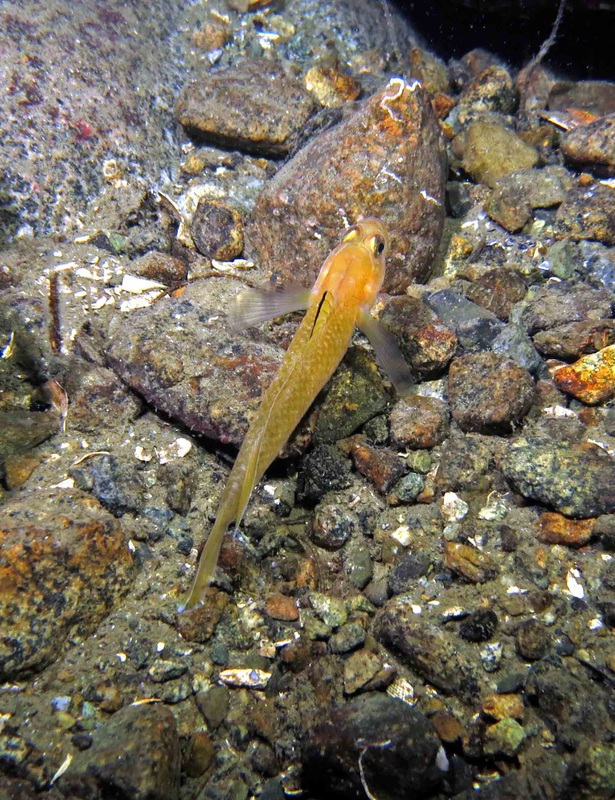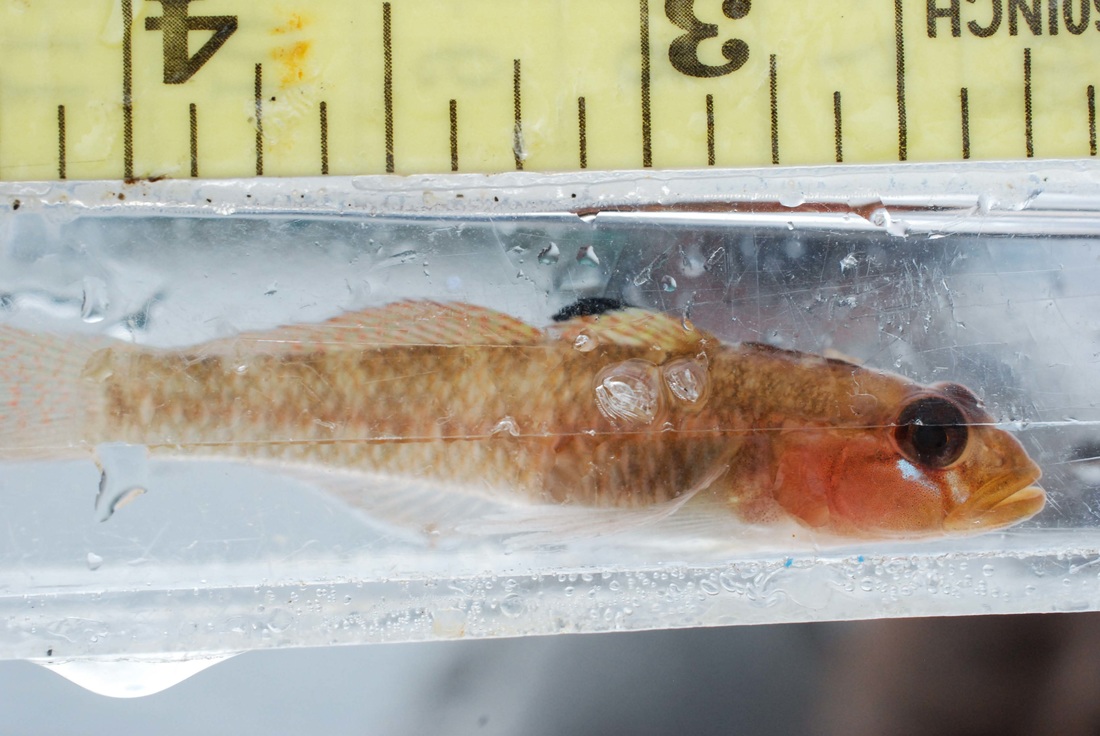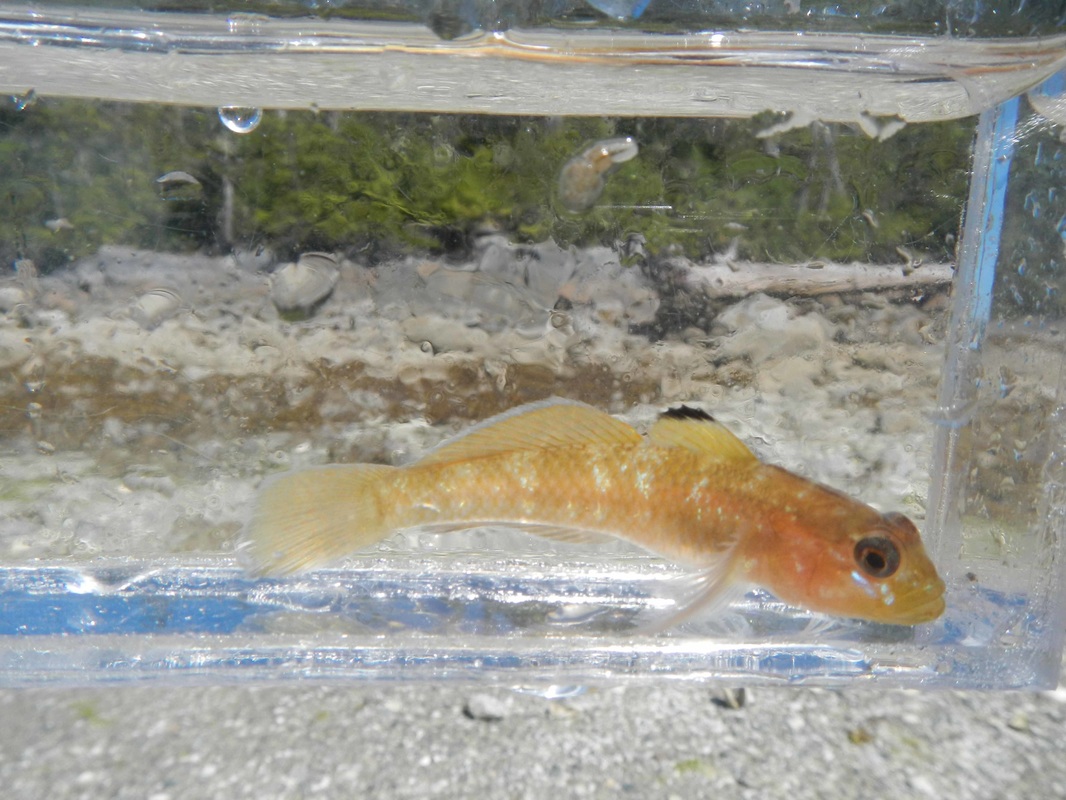Blackeye goby, crested goby, large-scaled goby, bluespot goby • Rhinogobiops nicholsii
Blackeye gobies photographed by Kelly Fretwell (bottom left), Kaia Bryce (top right), and Jenn Burt.
Identification
The blackeye goby, named for its distinctively prominent black eyes, can also be identified by the black spot at the front tip of its dorsal fin, the low crest that runs from behind its eyes to its dorsal fin, and its large scales. It has an elongated and light greenish, brownish, or tan body, and gets to 15 cm long. Like other gobies its pelvic fins are fused into a cone, which assists its pectoral fins in supporting it while it rests on sand or rock between swims. On the blackeye goby this cone, also called a pelvic disc, is also black.
Habitat & Range
The blackeye goby is found in sandy-bottomed habitats near rocks, from the intertidal to 106 m deep. Its range extends from southern Alaska to northern Mexico.
Intriguing Info
One male and several females will form permanent 'harem groups.' The male prepares a spawning site under a rock, raises his fins in part of a mating ritual that attracts females into this crevice, and then guards the nest after the female lays her eggs. A female will deposit up to 1700 of the tiny pink eggs at one time.
iNaturalist
https://www.inaturalist.org/taxa/132521-Rhinogobiops-nicholsii
The blackeye goby, named for its distinctively prominent black eyes, can also be identified by the black spot at the front tip of its dorsal fin, the low crest that runs from behind its eyes to its dorsal fin, and its large scales. It has an elongated and light greenish, brownish, or tan body, and gets to 15 cm long. Like other gobies its pelvic fins are fused into a cone, which assists its pectoral fins in supporting it while it rests on sand or rock between swims. On the blackeye goby this cone, also called a pelvic disc, is also black.
Habitat & Range
The blackeye goby is found in sandy-bottomed habitats near rocks, from the intertidal to 106 m deep. Its range extends from southern Alaska to northern Mexico.
Intriguing Info
One male and several females will form permanent 'harem groups.' The male prepares a spawning site under a rock, raises his fins in part of a mating ritual that attracts females into this crevice, and then guards the nest after the female lays her eggs. A female will deposit up to 1700 of the tiny pink eggs at one time.
iNaturalist
https://www.inaturalist.org/taxa/132521-Rhinogobiops-nicholsii
References
Froese, R. and Luna, S. M. Rhinogobiops nicholsii (Bean, 1882). FishBase. Accessed 17/09/2015.
Lamb, A. and Edgell, P. Coastal Fishes of the Pacific Northwest. Revised. (2010). Madeira Park, BC: Harbour Publishing. Pp. 102-103.
Lamb, A., and Hanby, B. (2005). Marine Life of the Pacific Northwest [electronic version]. Madeira Park, BC: Harbour Publishing.
Watanabe, J. Rhinogobiops nicholsii (Bean, 1882). SeaNet. Stanford University. Accessed 17/09/2015.
Authors and editors of page
Kelly Fretwell and Brian Starzomski (2015).
Froese, R. and Luna, S. M. Rhinogobiops nicholsii (Bean, 1882). FishBase. Accessed 17/09/2015.
Lamb, A. and Edgell, P. Coastal Fishes of the Pacific Northwest. Revised. (2010). Madeira Park, BC: Harbour Publishing. Pp. 102-103.
Lamb, A., and Hanby, B. (2005). Marine Life of the Pacific Northwest [electronic version]. Madeira Park, BC: Harbour Publishing.
Watanabe, J. Rhinogobiops nicholsii (Bean, 1882). SeaNet. Stanford University. Accessed 17/09/2015.
Authors and editors of page
Kelly Fretwell and Brian Starzomski (2015).








